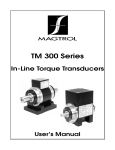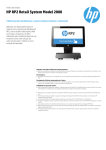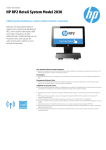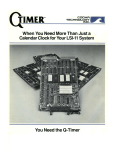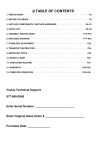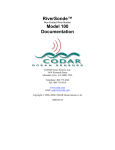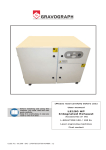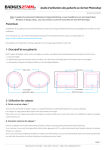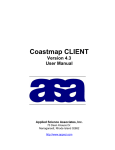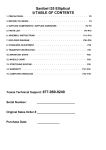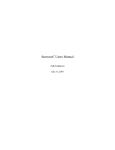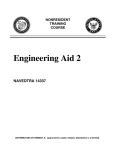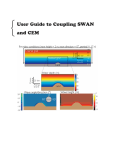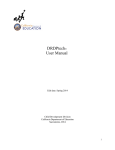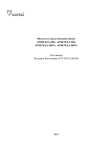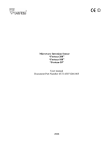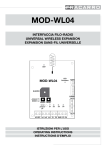Download to Complete SeaSonde Product Line Catalog
Transcript
Continuous Surface Current Mapping & Wave Monitoring System See The Ocean From an Amazing Perspective The SeaSonde HF radar system by CODAR Ocean Sensors is your solution for making continuous, wide-area ocean observations. The SeaSonde will provide you with years of real-time data over large coverage areas, with ranges up to 200 km -- This is not possible with any other technology! The SeaSonde is a compact, non-contact surface current and wave measurement system that can be deployed and maintained easily, and will perform even during extreme weather conditions such as hurricanes. High Quality Data CODAR Ocean Sensors' patented technologies, including our processing algorithms, allow the SeaSonde to produce extremely accurate 2-D surface current velocity maps and meausres the most important wave parameters. Patented antenna design and processing algorithms enable the system with up to 360º coverage. The patented pulsed FMCW eliminates the range aliasing and antenna wind-vibration noise inherent to other HF system designs. Focus on Your Application The SeaSonde is an off-the-shelf tool that allows you to focus on applying the data rather than the technology of collecting it. Whether your work efforts involve guiding search and rescue operations, providing critical information to maritime vessels, or driving and improving numerical circulation models, the SeaSonde will be an immense aid. System Highlights: Convenient: Nothing in the water: a truly non-contact sensor. All hardware is located on the coast or an offshore structure. The patented compact antenna design greatly simplifies siting requirements. Reliable: All system hardware and software are developed by our own staff specifically for continuous, longterm field operations, and consistent data outputs. Flexible: The software parameters are highly flexible, yet designed to work smoothly, eliminating any need for you to become a computer programmer or radar expert. Automated: Data can automatically arrive at your office at your preferred intervals, and can also be sent directly to the Web for public viewing. † Remote Access: Data retrieval, system monitoring, parameter modifications and even factory support are all conducted through system remote access. † Low Power: SeaSondes' low power consumption allow for working off-the-grid with alternative energy sources. Cross-Platform Data Format: All data products are stored as ASCII files for convenient data transfer to various computer platforms, incorporation into numerical models and GIS programs. Compatible with Coastal Culture: Where visual impact and minimum land-use footprint are all important, nothing beats the SeaSonde ultra-compact design. † Communication Link Required SeaSonde Configuration: Standard Hi-Res Long-Range Spatial Range (typical) Alongshore: 20-60 km 15-30 km 100-220 km Offshore: 20-75 km 15-20 km 140-220 km • Ranges achieved vary with environmental conditions and antenna placement. Note: Two radars are normally required for creating 2-D surface current maps of direction and speed. Range Resolution 500 m - 3 km 200-500 m 3-12 km • Resolution is user selectable. Angular Resolution: 1-5 degree grid: user selectable. Current Accuracy: Varies with environment. Comparisons with ADCPs located in close proximity to the surface are typically < 7 cm/s of the total current velocity and 1-2 cm/s of the tidal component. Wavefield Products (measured at each radar): Local on-shore wave conditions in ring centered ~3 km from coast around each radar. Significant Waveheight: typical accuracy: 7-15%; Dominant On-Shore Direction: typical accuracy: 5 degrees -12 degrees; Dominant Wave Period: typical accuracy: 0.6 s; Other spectral wave parameters available. Wave information is limited by environmental conditions and operating frequency. Frequency Range (antennae tuned to operate at a frequency subband within): Standard Hi-Res Long-Range one of either: one of either: 4.3-5.4 MHz 11.5-14 MHz or 24-27 MHz or 24-27 MHz 40-45 MHz • Patented technology permits the simultaneous operation of multiple radars on a single frequency, thereby minimizing frequency requirements and interference. • Operators must adhere to their country’s radio communications regulations regarding radiated signal specifications, and receive proper authorizations prior to operation. Consult company. Courtesy of D. Musgrave, U. Alaska Fairbanks Equipment Dimensions: SeaSonde Electronics Transmit Antenna Height: 4.8 m for 11-14 MHz Combined with RX 9m Transmit Antenna Post 4m N/A N/A Receive Antenna System (mast, dome loopstick antenna unit & vertical element atop dome) approx. total height 7m Receive Chassis: 13H x 49W x 53D cm. Weight:14 kg Transmit Chassis: 13H x 49W x 53D cm. Weight:15 kg Maximum Distance Between Adjacent Radars: Recommend 40-60% of the radar's offshore range. Power Requirements: Either 120 VAC or 220 VAC, 50-60 Hz; total onsite electronics varies between 350 and 500 watts depending upon peripherals desired. [24 volt DC versions also available] About CODAR Output Radiated Power: 80 watts peak, 40 watts average † For complete system specifications, please consult Technical Specification sheets available on company website. Transmit Antenna Receive Antenna CODAR Ocean Sensors personnel are the inventors and original developers of HF and VHF radar technology for ocean monitoring applications, some having been in this field for nearly 40 years. CODAR staff continue to make advancements in radar physics theory as well as product engineering refinements, and apply them to ensure the SeaSonde as the most reliable HF radar system in the world. The RiverSonde is their latest product to enter the market, and takes advantage of many key SeaSonde features. Headquarters: 1914 Plymouth Street SeaSonde data integrated into Google-based interface created by Scripps Institute of Oceanography (SIO). Data courtesy of SIO. Mountain View, CA 94043 USA Phone: +1 (408) 773-8240 Fax: +1 (408) 773-0514 Toronga, 31 Madrid, ES-28043 SPAIN Phone: +34 911263423 Fax: +34 911263424 email: [email protected] Web: www.codar.com VER-20100331 CODAR OCEAN SENSORS SeaSonde® Remote Unit System Specifications Product Code: SSRS-100 SeaSonde Remote Unit Components† • 1 Transmit Antenna Assembly (SSTA) & 1 Receiver Antenna Assembly (SSRA) OR, ! 1 Combined Transmit-Receive Antenna Assembly (SSTR) (avail. for frequencies 11.5 MHz and higher) • 1 Transmit Cable & 1 Receive Antenna Cable Set OR, ! 1 Combined Transmit-Receive Antenna Cable Set (avail. for frequencies 11.5 MHz and higher) • 1 SeaSonde Receiver Chassis (SSRX) • 1 SeaSonde Transmitter Chassis (SSTX) • 1 Radial Site Data Acquisition System (SSDA 100) • 1 Electronics Interconnector Cable Kit • 1 Set Operator Instruction Manuals, PDF format • One Year Manufacturerʼs Warranty † Base components only: review Remote Unit Configuration Options inside this specification sheet. Technical Specifications RADIATED SIGNAL SPECIFICATIONS Operators must adhere to local radiated signal regulations and receive proper authorizations prior to operation. Output Radiated Power: 80 W peak, 40 W average Operating Frequency Range: Receive Antenna (SSRA) ! Electronics: 4.4 – 50 MHz or ! Antennas: Select from one of either: Combined Transmit-Receive ! 4.4-6 MHz or Antenna (SSTR) ! 11.5 - 14 MHz or ! 24-27 MHz or ! 40-45 MHz or ! custom: any other frequency between 4.4-50 MHz Modulation Format: Pulsed Swept Frequency CW Sweep Width: 12-300 kHz (typical) Pulse Repetition Frequency: 514 - 8224 Hz Sweep Repetition Frequency: 1-4 Hz Total Radiated Signal Bandwidth: (at -20dB level) 65-200 kHz Polarization: Vertical System Power Requirement (transmitter, receiver & SSDA 100 computer): 350 watts (24V DC ver.) or 500 watts (120-220 VAC) (SSTA) SSTX SSRX RECEIVER TRANSMITTER Transmitter Chassis: SSTX Input RF Drive Level: 0 dBm Output RF Power Level: 100 watts peak, 50 watts average Power Requirements: 300 watts; ! (select one when ordering): 120 V AC, 50-60 Hz 220 V AC, 50-60 Hz 24 V DC Design: (gated FET) modular; solid state Operation: Class AB Dimensions: (single chassis) 19” rack mountable, 3U tall; 13H x 49W x 53D (cm) Weight: 15 kg Temperature Range (ambient): 0˚ F (-18˚ C) to 90˚F (32˚ C) Maximum Humidity: 80% non-condensing SSRS-100 specification, v4, rev 03/2010 Receiver Chassis: SSRX Maximum In-band Input Level: 0 dBm Receiver Channel Impedance: 50 ohm Sensitivity (noise level): -166 dBm in 1 Hz BW Power Requirements: 100 watts; ! (select one when ordering): 120 V AC, 50-60 Hz 220 V AC, 50-60 Hz 24 V DC Design: modular, solid state, three-channel Operation: I/Q homodyne Output: USB digital output; digital data at 4096 16-bit/ second per channel Dimensions: (single chassis) 19” rack mountable, 3U tall; 13H x 49W x 53D (cm) Weight: 14 kg [ Optional “SHARE” GPS synchronization Feature: GPS assisted stability: >.0001 ppm and 50 nsec on PPS ] Temperature Range (ambient): 0˚ F (-18˚ C) to 90˚F (32˚ C) Maximum Humidity: 80% non-condensing System Requirement: AC Power Conditioning via Uninterruptable Power Supply (UPS). Minimum recommended UPS capacity: 1500 VA (1050 Watt) ANTENNA CABLING Requirement- Cabling Protection: Ideally cables between antennas and electronics are fed through protective conduit (such as 3.5 cm diameter PVC pipe) and buried in trench. There are lower cost options available, but there will be greater risk to exposure and damage. Transmit Cable Type: Single Strand RG-8 Low loss Co-Ax, 75 m length Receive Cable Set Type: Quad strand RG-58 Low loss Co-Ax bundle, 100m length Combined Transmit- Receive Cable Set (for 11.5 MHz and higher frequency bands) Type: 1 x RG-8 + 2 x RG-58 Low-loss Co-Ax bundle, Length: 75m (optional custom lengths available) ANTENNA ASSEMBLY Note: Antennas for operation at one frequency band and bandpass filters for operation at two frequency bands are included with SeaSonde remote unit purchase. Antennas and filters for operation at additional frequency bands can be purchased separately. Requirement- Bases/Mountings for Antennas: Antennas need to be mounted vertically secured to concrete concrete pad (~ 1m x 1m 1m) or lashed/guyed to fencing or other solid structure. Read SeaSonde Antenna Installation User's Guide for examples. Receive Antenna Assembly Consists of: ! mast, ! dome loopstick antenna unit & ! vertical element (set atop dome) Durability: All-weather Total antenna height: ! 4.3 - 5.4 MHz: approx. 6.5 m ! 11.5- 14 MHz: approx. 6.5 m Design: passive vertical monopole, two crossed loops into preamplifiers Functionality: omnidirectional, adjustable (in software) from 1-360 degrees Transmit Antenna Durability: All-weather Total height: ! 4.4- 5.3 MHz: approx. 8.6 m ! 11.5-14 MHz: approx. 8.6 m Transmitting Design: vertical monopole; omnidirectional Combined Transmit-Receive Antenna Assembly (for 11.5 MHz and higher frequency bands) Consists of: ! mast, ! dome loopstick antenna unit & ! vertical element (set atop dome) Durability: All-weather Total antenna height: ! 11.5- 14 MHz: approx. 8 m ! 24-27 MHz: approx. 6.5 m ! 40-45 MHz: approx. 5.5 m Receiving Design: ! passive vertical monopole, two crossed loops into preamplifiers ! omnidirectional, adjustable from 1-360 degrees Transmitting Design: vertical monopole; omnidirectional Requirement – SeaSonde Antenna Placement Clear Space Around RX and TX Antennas Objects that interact with or alter the response of the transmit or receive antennas can affect bearing accuracy or create bearing gaps in coverage • Position SeaSonde transmit or receive antennas one horizontal RADAR wavelength or greater away from tall (one quarter of the RADAR wavelength or taller) objects or obstructions (see chart below). Tree trimming/removal, or relocation of other man made objects may be necessary. • There should be no obstructions between the receive antenna and the seaward side that may block energy in direction of ocean • Position receive antenna one horizontal RADAR wavelength or greater away from a cliff or building edge (see chart above). Requirement- Transmit Antenna Ground Plane Dimensions The Long-Range (4.3-5.4 MHz) SeaSonde Transmit antenna requires a ground plane. If the antenna is attached to a metal structure, such as on an oil platform or metal fence, then that object will act as the grounding device. If it is to be installed on a beach, for example, then grounding elements will need to fan out from the base of the antenna towards sea. A minimum of 9 elements need to be placed in a 180º semi-circle on the seaward side of the antenna. Each element is a metal wire encased in plastic (~1/8” diam.), whose length is about 7-8 m. These elements can be buried under sand or laid above ground. Distance (Horizontal) from Water to Antennas Antennas should be positioned close to the water to prevent propagation loss of energy traveling over ground. Maximum recommended distance from transmit or receive antenna to water is four RADAR wavelengths (see above chart). SSRS-100 specification, v4, rev 03/2010 RADIAL SITE DATA ACQUISITION SYSTEM (SSDA 100) SSDA 100 Consists of: ! Computer: select one of either mini-style or laptop computer ! ! ! Monitor: color TFT keyboard and mouse: USB, extended Radial Suite Software License (individual site use) Temperature Range: 0˚ F (-18˚ C) to 90˚F (32˚ C) for mini-style computer Maximum Humidity: 80% non-condensing Compatible Communications: 10/100/1000 Base-T Ethernet (RJ-45 connector) & Others (such as dial-up modem). Automatic transfer of current, wave and diagnostic data products supported by software for dial-up lines and ethernet connections. Communication Link Requirement • A reliable data communications link is required for: • Real-time data transmission, • Real-time system monitoring, • Proper system maintenance and customer support, • Remote software updates. • Minimum data bandwidth (upload and download each): 256 kbit/s. Radial Suite Software Data Products Radial Surface Current Velocity Maps Radial Map Display: color monitor screen, archived ASCII vector files-formatted to CODAR's LLUV columnar table format (MatLab® loadable). Spatial Range (typical): 20-220 km offshore; 20-220 km alongshore Range Resolution: user selectable from 200 m - 12 km. Resolution is based on transmit signal sweepwidth. Angular Resolution: 1-5 degree grid: user selectable. Current Accuracy: Varies with environment. rms typical for normal environmental speed: < 7 cm/s of the total current velocity and 1-2 cm of the tidal component, direction < 10 degrees. Doppler Cross Spectra Binary files of HF sea echo spectra for three receive channels (two crossloops & vertical element). Raw and averaged are available for processing into radial vector maps. Range Processed Spectra (Range Series) Optional binary files of receiver range processing which can be processed into Doppler cross spectra. Raw I & Q voltages (Time Series) Optional binary files of receiver analog measurements which can be processed into range spectra and Doppler cross spectra. Wave Field Parameters Local on-shore wave conditions in ring centered 3km from coast around each radar. Measurement range cell user-selectable. Significant Waveheight. typical accuracy: 7-15% Dominant on-shore Direction. typical accuracy: 5-12 degrees Dominant Wave Period. typical accuracy: 0.6 s Waveheight Energy vs. Frequency: ~0.01 Hz spacing Dominant Wave Direction vs. Frequency: ~0.01 Hz spacing Spectral Wave Frequency Range: 0.05 Hz - 0.25 Hz (20 s to 4 s periods) Minimum Detectable Significant Waveheight: 1 m Data Temporal Interval: User selectable. Typical wave averaging performed over one hour Wave History Displays: hourly waveheight vs. time. Hourly wave direction vs. time. Hourly wave period vs. time (Note: Wave information is limited by environmental conditions and operating frequency. ) Diagnostics ASCII or image of diagnostic time series data for system hardware, software and data performance parameters. ASCII files are formatted to CODAR's columnar table format (MatLab® loadable). SSRS-100 specification, v4, rev 03/2010 SeaSonde Radial Software Suite Functions: • Real-time autonomous operation • Real-time system monitoring, logging & alerts (via email) • Hardware • Temperatures • Voltages • Data Acquisition • Miscellaneous Hardware • Software • Applications/Tools running (relaunch if not) • Data collection & processing operations • Acquisition and archiving • Configuration done via Graphical User Interface • Layered configurable properties for both basic and advanced functions • Graphical or command line control and monitoring • Visualization Software for all stages of data (raw binary I & Q to vector maps) and diagnostics • JPEG or PNG plot images for sharing via email or web publishing • Data archiving utility • External Antenna Response Calibration & Implementation • Multiple levels of configurable Quality Control: • Signal-To-Noise Computation & Thresholding • Peak Identification & Characterization • Ship Echo Removal • Burst Interference Removal (Lightning & Others) • Ionospheric Noise Removal • Outlier Detection & Removal 2009 SeaSonde Remote Unit Configuration Options Choose a primary frequency band, then choose your options Std: option part of standard configuration N/C: option available at no extra charge $: option available for a fee in addition to the base price ➡ Options ➡ Power Supply (select one) 40 - 45 24 - 27 12 - 14 4-6 Custom 110 V (AC) Std Std Std Std Std 220 V (AC) N/C N/C N/C N/C N/C 24 V (DC) $ $ $ $ $ Std N/C N/C N/C Std N/C N/C Std N/C 40-45 MHz Second Rx Chassis Filter Set (select one) 24-27 MHz Std 12-14 MHz N/C N/C $ $ $ Std $ N/C N/C Std Std N/C Twin Transmit Antennas $ $ $ Dual-Transmitter & Twin Tx Antennas $ $ $ GPS-enabled Frequency Multiplexing (SHARE) Single Transmit Antenna Antenna Configuration (select one) Tx & Rx Separate Tx & Rx Combined Tx/Rx Cable Combine Tx/Rx Antenna Only (select one) Rx Cable 1 X RG-8 2 X RG-58 4 X RG-58 Separate Antennas Only (select one) 3 X RG-8 Tx Cable Separate Antennas Only Frequency Bands 1 X RG-8 (select one) Std Std $ Consult 75 meters Std Std $ Consult price per meter (beyond 75 meters) $ $ $ $ $ 100 meters N/C N/C Std Std N/C $ $ $ $ $ $ $ $ $ $ price per meter (above 100 meters) $ $ $ $ $ 75 meters N/C N/C Std Std N/C price per meter (above 75 meters) $ $ $ $ $ $ $ $ $ $ Mini Std Std Std Std Std Laptop $ $ $ $ $ SeaSonde Radial Suite Std Std Std Std Std Multi-Static Processing $ $ $ $ $ $ $ $ $ $ price per meter (above 100 meters) 100 meters Extended Lightning Protection Kit Computer Type (select one) Software (single-use license) Manufacturer’s Limited Warranty Extension (annual price after first year) SSRS-100 specification, v4, rev 03/2010 March 2009 Pushing the Range of Your SeaSonde Hardware configuration options to expand the observable range of your SeaSonde, potentially beyond 300 km Operating Frequency O ne easy way to achieve greater range is to operate at a lower frequency band. This has been known for decades, and is the reason CODAR engineers designed the SeaSonde for operation across a wide band, ranging from 4.4 MHz up to 50 MHz. The lowest of the SeaSonde transmit frequency bands within 4.4 6 MHz allows for greater ranges than the higher bands without any increase in radiated power. In general, the average daytime observable range achieved by a SeaSonde operating near 46 MHz LongRange mode is typically 160220 km. Actual coverage varies on many factors, such as exact antenna placement, sea conditions, external noise as well as some userselectable software settings. Twin Transmit Antennas Another method for increasing observable range is adding a second transmit TX antenna. A single monopole antenna exhibits a uniform, omnidirectional transmit signal pattern, meaning that the radiated power is equally distributed across 360 degrees including sections over land. The simple addition of a second transmit antenna allows for beam control and through proper orientation & phasing the antennas can direct more power transmitter signal power out towards sea. It is most common for this conguration to be used on the lower SeaSonde bands 514 MHz, but is possible at any frequency. This hardware conguration option is available when ordering a new SeaSonde Remote Unit or as a retrot. The ocial name is Twin Transmit Antenna Conguration. The directionality of the beam fan produced by the TX antenna pair can be controlled by adjusting the spacing between the two elements. Spacing the two elements closer together will cause the signal strength to fan out, so that the power is spread across a wider angle. As the two antennas are pulled apart, the resulting beam pattern becomes narrower, sending a stronger signal out towards a more specic angular sector. This produces even greater range, but inside a narrower angle sector. The antenna spacing and hence the TX beam fan spread is customized at the radar site and optimized for that SeaSonde users goals. Dual Transmitter - Twin Transmit Antenna Configuration for Maximum Range SeaSonde Coverage to 334 km Shown A third way to extend range is to increase the TX radiated power. However, when it comes to increasing power, one quickly reaches the point of diminishing returns on investment. The SeaSonde transmitter output power is 40 watts average, which is low and also highly practical from a design and results perspective. Increasing the output power of a single transmit power supply creates more internal heat, placing more wear on itself and other nearby parts inside the transmitter chassis. Hence these other parts, including heat sinks, must be upgraded to perform under this greater heat stress. This drives the price of a radar up to an uncomfortable cost level. Instead of increasing power from a single transmitter, CODAR oers a more practical solution that is addition of a second transmitter. This SeaSonde Remote Unit conguration is referred to as SeaSonde Dual Transmitter Twin Transmit Antenna Conguration. In this setup, two transmitters are connected to a set of twin TX antennas. This doubling of the transmit power and the focusing its beam out towards sea can make a dramatic dierence in daytime observable range, extending it by as much as 90 km. To put this into perspective, the range increase is the same as would result from a single transmitter with a single antenna that had its power increased from 40 to nearly 200 watts. A deployment of the special conguration units several years ago in the Gulf of Mexico had radars positioned at bottom of the Southwest Pass in Louisiana and on an oil platform to the west. Daytime average observable ranges for these units consistently stayed above 240 km and at times the Southwest Pass radar unit had ranges up to 340 km were reached. Data Produced by LongRange SeaSonde A demonstration of range improvement was conducted in September 2008. Data from a Long-Range SeaSonde unit operating in Bodega, California is shown above. Normal range of this unit is 170-190 km. When the system hardware is modified to Long-Range SeaSonde with the dual transmitter twin TX antenna configuration the current maps extend out past 300 km in certain sectors. Data Produced by Dual TX- Twin TX Antenna Long-Range SeaSonde Above: The odd-shaped Vermilion 31A oil platform, nearly 1000 meters long, had plenty of space for the LongRange twin TX antennas and receive antenna. Center Right: Total vector current map produced by combining the Vermilion & Southwest Pass radials, extending to 334 km offshore. Right: SeaSonde antennas at Southwest Pass were installed in marshland only accessible by boat. CODAR o c e a n s e n s o r s 1914 Plymouth Street, Mountain View, CA 94043 USA Phone: +1 408 7738240 Fax: +1 408 7730514 Email: [email protected] www.codar.com March 2009 Protecting the SeaSonde from Lightning and Other Electrical Surges An ounce of prevention is worth a pound of cure T he occurrence of lightning striking SeaSonde antennas is extremely low. However, the statistics vary geographically and even a small risk exists at any coastal HF radar location. Some may ask, “what can be done to prevent the antenna from being struck by lightning?”. Unfortunately there are no devices that can prevent a strike on the antennas without disrupting their normal performance. There might be some very sophisticated antenna protection system that may not negatively affect the antennas, but these expensive designs cost more than the price of entire SeaSonde unit and still can offer no guarantees. All SeaSondes are equipped with some lightning protection built into the transmitter chassis and the receive antenna (shown below). The purpose of these devices is to minimize the effects of a lightning strike upon the more expensive parts of SeaSonde electronics if an antenna is hit. The SeaSonde Extended Lightning Protection Kit, CODAR Product Code LTE1, (shown below) is an optional secondary lightning protection package set in a small weatherproof housing (mountable either indoors or outdoors) intended to provide one additional layer of electronics protection. It uses the same gas discharge tube method on all transmit and receive cables connected to the electronics. It is not a guarantee against damage but is another technology that may help protect the electronics chassis (if either antenna or antenna cables take a direct hit). Lightning can also hit buildings and power lines-- a hit to either can send strong surges of voltage through the building electrical system and damage electronics. Power coming to SeaSonde should be buffered via an Uninterruptable Power Supply (UPS) Power Conditioning Unit (CODAR Product Code UPS1500). A UPS connecting the SeaSonde unit to its power source (e.g. wall plug) will provide a layer of protection to electronics against power surges that come from power line. They also allow for continued quality performance through power fluctuations (sometimes referred to as “brownouts”). UPS devices are small investments with big rewards. Consult CODAR Support Team for additional details on protection technology and how these may be best utilized inside your SeaSonde network. CODAR Product Code UPS1500 CODAR Product Code LT-E1 CODAR o c e a n s e n s o r s 1914 Plymouth Street, Mountain View, CA 94043 USA Phone: +1 (408) 773-8240 Fax: +1 (408) 773-0514 E-mail: [email protected] www.codar.com SeaSonde Central Site Management / Data Combining Station Product Code: SSDP-100 or SSDP-100EX Description: The SeaSonde Central Site is the hub for monitoring and combining data from all the Remote Units in your entire SeaSonde network. Manage data transfers from remote sites so that you can produce and display the most up-to-date current maps. Display diagnostic data in one convenient place for quick operator access. SSDP-100 hardware can be installed locally or in a data center thousands of kilometers away. Data can be combined from standard SeaSonde remote unit traditional radial vector maps and also from the new ellipitcal vector maps that will increase data density and expand coferage area. Multi-stage automatic Quality Control is built in to the processing to meet real-time operational needs. Additional software allows for value-added information from your data like real-time drifter tracks and sub-diurnal time scale filtering, among others. Whether you have two sites or 24, the Central Site unit will make monitoring and management of your SeaSonde network a streamline task. SSDP-100 Includes: Computer: Macintosh desktop quad core xeon 2.8GHz 2GB RAM 256GB HD or later. USB Keyboard and Mouse. Display: Color, 23" HD Display. Software: Combine Station Suite software license (for interaction with up to six SeaSonde Remote Units). Note: SSDP-100EX is “extended version” of SSDP-100 designed for interaction and combining data with up to 24 SeaSonde Remote Units. Temperature Range: 0˚ F (-18˚ C) to 90˚F (32˚ C) Maximum Humidity: 80% non-condensing Compatible Communications: 10/100/1000 Base-T Ethernet (RJ-45 connector) & Others (such as dial-up modem). Automatic transfer of current, wave and diagnostic data products supported by software for dial-up lines and ethernet connections. Communication Link Requirement • A reliable data communications link is required for: • Real-time data transmission, • Real-time system monitoring, • Proper system maintenance and customer support, • Remote software updates. • Minimum data bandwidth (upload and download each): 256 kbit/s. Output Data Product Specifications: Surface Currents: Maps of surface currents created from data taken at two or more radar sites Map Displays: color monitor screen, archived ASCII vector files Map Spatial Resolution: (vectors on grid) user configurable; 200m x 200m up to 12 km x 12 km typical spacing Map Area Coverage: user configurable; typical minimum 20-50 km alongshore x 20-30 km offshore or greater Map temporal interval: user configurable; minimum 15 minutes, typical 1 hour Map vector accuracies: better than 10 degrees Combine Site Software Suite††: Application. Sentinel AnalyzeCurrents CheckForRadials RadialsToCurrents TotalArchiver Archivalist SeaDisplaySetup FileExchange Function. real-time startup. log status events. track applications. real-time script to process radials and ellipticals into total current vectors. determines which newly transferred radials and ellipticals need to be processed. combine radial and elliptical vectors into total current vectors. finalize total current vectors into output LonLatUV format with much metadata. archive output data and diagnostics on site to manage disk space to help with data retrieval. create a customized coastline site map. suite of scripts and tools for real-time transfer of data (typically radials, waves and diagnostics) from the remote radial sites using Timbuktu® (IP or Modem) or ssh over IP. CODAR Product Code SSDP-100 and SSDP-100EX information sheet, v2, revised 06/2009 Data Display Tools. Data at all levels can be displayed on plots controlled by simple graphical user interfaces. For example, raw or averaged cross spectra can be plotted in 3D color form or as time-series/spectral curves. Wave data have several formats for display. Radial and total current-vector map algorithms include coastlines and bathymetry contours, with several full-color options for vector and uncertainty displays. The latter tools also permit easy creation of movies over time, and vector density coverage distributions for diagnosis. Touching the screen with a mouse-click, for example, gives a numerical value for any vector or uncertainty at that point. SeaDisplay. Plot total, radials and ellipticals over coastline site map. create and modify total vector grid. create image output. create movies over time. Vector display software allowing statistical analyses of multiple current-map data sets and their errors that will compute statistics (i.e., means, root-mean-square differences, and standard deviations) over a period of time as user selects. WaveDisplay is another useful application used to visualize wave data gathered by CODAR systems. WaveDisplay can plot wave time series from one range cell or multiple ranges in one display Data Transfer Software & Protocols. Both the central site and radial/remote sites come equipped with several tools that facilitate scheduling and executing data transfers. Software (such as Timbuktu) delivered will also permit interactive control and transfers between any site to any location in the world. This software has been refined after many years and thousands of hours of use. Movie making capability that allows users to make a movie of vector fields or radial velocity maps over any period for which data were observed. Drift and trajectory calculation and plot display movies. †† Many more useful utilities are included. Refer to operation manual for complete description of software features. CODAR Product Code SSDP-100 and SSDP-100EX information sheet, v2, revised 06/2009 Enhancing SeaSonde Networks With Bistatic / Multi-Static Functionality New Multi-Static Software for SeaSondes Multi-static function is a straightforward augmentation that will allow expanded and improved current-mapping coverage inside a SeaSonde network. This patented technique has been under development at CODAR for over ten years and is now available for commercial release. The subsequent sections describe the technology and how it can be used to enhance both new and existing SeaSonde networks. Defining Monostatic & Bistatic Every SeaSonde, and all other commercial ocean observing HF radars, are backscatter -- or monostatic -- radars. This means transmitter and receiver are co-located together. When the transmitter is positioned away from the receiver by tens of kilometers, this unconventional variation is called "bistatic". The Bistatic Geometry Made Simple A backscatter radar measures observables like currents in a polar coordinate system. Contours of constant time delay are range circles about the radar. Doppler shift from the transmitted frequency gives a velocity component along bearing spokes from the radar, and these are called "radials", i.e., perpendicular to a radial circle. A bistatic radar measures observables in an elliptical coordinate system, where constant time delay contours of the echo are ellipses. This family of ellipses has the transmitter and receiver locations as the ellipse focal points. Doppler shift gives a component of velocity that falls on hyperbolas passing perpendicular through the ellipses. These velocities are referred to as "ellipticals". The measurements below illustrate radials and ellipticals measured off the coast of New Jersey with a bistatic-enhanced SeaSonde. An example of "radials" and "ellipticals" for a New Jersey-sited 25-MHz SeaSonde with a buoy-mounted bistatic transmitter is shown in the above figure. These are measured and processed simultaneously Why Bistatic Radars Are Uncommon in HF Ocean Observing In any radar, the transmit signal must be coherent with the receiver signal generator. That's easy when they are together, because the same signal source can be used for both. When they are separated, accurate frequency and time synchronization is the drawback. CODAR invented and patented a methodology based on GPS timing along with CODARʼs unique, patented FMCW (frequency-modulated continuous wave) gated signals to control the exact sweep time of multiple transmitters down to nanoseconds so all transmitters can occupy the exact same frequency channel. This enables a single receive antenna to process unambiguously scattered signals from multiple transmitters. The signals from various transmitters are identified and separated in the demodulation phase. Defining Multi-Static: Simultaneous Monostatic & Bistatic Operation Bistatic wouldn't have significant value if a network still ended up with the same quantity of data, the only noticeable difference being that transmitters and receivers are separated from each other (switching from monostatic to bistatic). However, this is not the end of the process; With the CODAR-patented methods, one receiver can see its own backscatter echoes and produce radial maps, and can also see those signals from several other appropriately placed transmitters and process each of those transmitter signals to produce ellipticals, all at exactly the same time (not sequentially by on/off switching). This is called "multi-static". It can both extend coverage and increase data density inside monitoring area. Coverage and quality of four backscatter Long-Range SeaSondes off the coast of New Jersey. Dark red indicates best quality of total vectors; yellow going to white indicates poor or no coverage. Enhancement obtained by adding a transmitter on a buoy 150 km offshore, operating multi-statically with the four SeaSondes on the left. Higher quality (darker color) and greater coverage area. The Bottom Line: Benefits of Multistatic Function One can expect an extension in coverage area. This can vary between 30% (e.g., where only the existing coastal SeaSonde radar transmitters are used) up to 100% if stand-alone bistatic transmitters are judiciously placed (along coast, on buoys, islands or offshore structures). CODAR staff have tools to help predict and optimize this coverage based on your existing or proposed network. One can expect more robust, accurate current vectors, and fewer gaps within the existing coverage area. More measurements from different angles of the current field at a point will lead to a more accurate total vector. The figures above show an example where a buoy transmitter is added to augment an existing four-SeaSonde coastal network off New Jersey. Here the coverage area has more than doubled, and the darker shading denotes more accurate total vector mapping. Transmit Sources For Bistatic / Multi-static Networks Scenario #1: Utilizing Transmit signals from other SeaSonde Remote Units A transmitter from one conventional, backscatter SeaSonde remote unit can be the source for bistatic echoes for any of the other nearby SeaSonde receivers (inside a different SeaSonde remote unit). If a network of overlapping backscatter SeaSondes is already in place, producing total vector maps among them -- and they have our GPS-assisted timing package called "SHARE" -- this can be the foundation of a multi-static network. In this case, without adding any additional hardware the SeaSonde network can be converted into a mutli-static network by installing CODARʼs new bistatic/multi-static signal processing software package at some or all of the receiver stations inside network. For example, four adjacent backscatter SeaSondes can be converted into as many as ten multi-static echo sources for the same patches of sea. Scenario #2: Adding Stand-alone Bistatic Transmitters to a SeaSonde Network As orientation between transmitters and receivers affects the bistatic coverage area, there can be benefit to placing additional transmitter(s) at strategic locations. The stand-alone bistatic transmitters offered by CODAR consist of a transmitter, transmit antenna, and an Iridium communication link for simple remote control of transmitter. These units cost less than a complete SeaSonde Remote Unit and require less space and infrastructure, allowing operation inside an even wider variety of environments. The fact that there is no receive antenna reduces siting constraints. Absence of a computer and receive system lowers the overall power requirement significantly (the bistatic transmitter and Iridium link require approximately 100 watts power total). Refer to SeaSonde Bistatic Transmitter Product Information Sheet for further details. What Is Needed? If this is an existing SeaSonde backscatter network outfitted with SHARE technology, it needs only software to convert into a Multi-static network: one software package for Shown here is SeaSonde bistatic for each receiver (SeaSonde remote unit) that is to receive bistatic echoes from any transmitter mounted onto buoy off New Jersey coast. number of transmitters. This software package will be configured and keyed to that single receiver. For example, suppose one SeaSonde remote unit is to receive echoes from three other coastal SeaSonde remote unit transmitters, you need only one software package for that receiving SeaSonde remote unit and it can produce one set of radials and two or three sets of ellipticals. Additional software packages are required for each additional receiver that will be processing data bistatically or multi-statically indie the network. CODAR staff can help select which SeaSonde remote unit transmitters will work best with others in the vicinity, with a special visualization code. This shows the expansion in coverage area, as well as the increase in robustness within the existing backscatter map region. One may consider stand-alone transmitters along with the existing or proposed coastal network. These bistatic transmitters could be on buoys, on an offshore platform or island, or at a coastal point. Again, CODAR staff can help decide if and where such an option might be desirable, using the visualization code mentioned above. In this case, it will be necessary to purchase the additional bistatic transmitter hardware, while the need for receiver Bistatic/Multi-static data processing software packages remains the same. Contact CODAR for further details. SeaSonde Multi-Static Data Processing Software Package (single-use license) CODAR Product Code: SSDA-ES100 Product Description: The multi-static data processing software package enhances the conventional backscatter "Current" tool that produces radial velocities from SeaSonde echoes, by enabling processing of sea echoes from separated transmitters. The result is a set of bistatic elliptical files for each set of echoes that originate from synchronized transmitters included within radar range. For example, if three transmitters are within range and synchronized -- as well as that station's transmitter -- then four sets of current scalar-velocity estimates are produced. These follow the same LLUV formats (latitude/longitude/u/v) as standard backscatter radials, so that subsequent algorithms will recognize and utilize them, including combining tools to get total vector maps. This ensures that the outputs are backward compatible with existing downstream algorithms. The advantage of augmenting to multi-static operation by employing the signals from additional transmitters is the improved total-vector current-map coverage, both in extended area as well as more accurate vectors within the included area. SSDA-ES100 Includes: • Single-use software license • Firmware key (for activation) • Instruction guide (PDF) Multi-Static Data Processing Software Package Features: Examples of radial velocity vector maps from conventional backscatter method (left) and a bistatic elliptical map (right) both simultaneously produced at same SeaSonde receiver, utilizing multiple transmitter signals and calculated with the multi-static data processing package. • Extends area of total vector coverage from standard backscatter geometry • Increases total-vector accuracy and robustness within coverage area • Is keyed by firmware code to the designated receiver/computer • Accepts multiple bistatic echo sets from input cross spectra • Output file in standard LLUV ASCII format • Output files accepted by all present downstream processing tools • Includes same QA/QC data (e.g., rms uncertainties) as basic current tool • Expands basic meta-data to give additional relevant multi-static information regarding current ellipticals included in the file Technical Specifications † Requirements: Valid Existing Software Licenses: SeaSonde remote unit data processor (computer) comes with a valid basic SeaSonde remote-unit radial-suite processing package with a single-user software license. By procuring the new multi-static software package, elements of the existing processor are replaced and an additional single-user license is included, enabling proper operation of the new multi-static capability. Radial Suite software version: The radial suite software package running on the computer should be at least Release 6 or updated to our latest version prior to installation of multi-static data processing package. Computer: PowerPC or Intel running on at least OS X 10.4.11 with 512kB ram (10.5 preferred with 1GB ram) Special Setup: Recommend use of measured antenna pattern with 1 degree spacing. Installation & Activation When this software package is purchased, it is keyed and tied to a firmware chip that CODAR will supply. This chip resides in the SeaSonde Receiver chassis, on a USB hub. This allows security by ensuring that the singleuser licensed tool will run only with that unit, providing authorization to the owner and ensuring protection against theft or copying for use on unlicensed systems. †Specifications and appearance are given as guidelines and may change without notice. SeaSonde Information & Specifications- Version 1 created 12/2008 SeaSonde Bistatic Transmitter Package CODAR Product Code: SSBT-100- (-0005, or -0012, or -0025, or 0042) Product Description: The SeaSonde bistatic transmitter package is a stand-alone, SHARE-enabled transmitter unit for operation inside a SeaSonde network. An Iridium communication device included in package allows for remote transmitter control, including basic functions such as on/off, frequency switch, and modification of waveform parameters. The low-power requirements and built-in communication solution make the bistatic transmitter ideal for even the most remote environments. Includes: SeaSonde SHARE-enabled transmitter, SeaSonde transmit antenna assembly, RG8 transmit antenna cable (75m), GPS bullet antenna and cable, Iridium satellite modem Model 9601-D-I, antenna, and antenna cable, User Manual (PDF). 1-Year manufacturer warranty Iridium 1-year subscription service also included. Note: Subscription service need be renewed and paid by customer upon first year subscription expiry. SSBT-100 Technical Specifications † Radiated Signal Specifications Operators must adhere to local radiated signal regulations and receive proper authorizations prior to operation. Contact company for more information. Radiated Power: 40-50 watts Transmit Frequency Range: 4.4 – 50 MHz Modulation Format: Pulsed, Swept CW Sweep Widths (Typical): 12-300 kHz Sweep Repetition Frequency: 1-4 Hz Polarization: Vertical Transmitter Chassis: SSTX Input RF Drive Level: 0 dBm Output RF Power Level: 50 watts average Input Requirements: 24 V DC Transmit Cable Single RG-8, 75m length Transmitter electronics work at entire range of SeaSonde frequency bands. Select Product Code based on the desired antenna operating range: 4.3- 5.6 MHz: CODAR Product Code SSBT-100-0005, 12-14 MHz: CODAR Product Code SSBT-100-0012 24-27 MHz: CODAR Product Code SSBT-100-0025 40-44 MHz: CODAR Product Code SSBT-100-0042 SeaSonde Bistatic Transmit Antenna Dimensions Note: Antennas for operation at one frequency band and bandpass filters for operation at two frequency bands are included with system purchase. Antennas and filters for operation at additional frequency bands can be purchased separately. TX antenna Height (m) Frequency (MHz) Mast 4.3 - 5.6 None 12 - 14 4 24 - 27 4 40 - 44 4 Whip 11 5 2.4 1.4 Total 11 9.1 6.5 5.5 Horizontal Radial Elements (m) 8 (G) 2.4 (W) G) Radial elements are protected wires strung out from antenna base on ground surface (W) Radial elements are whip antennas extending from base of whip antenna Transmit Antenna Ground Plane Dimensions All transmit antenna ground planes (except the LongRange transmit antenna) have two horizontal whip elements that protrude from antenna just above the 4 m tall mast. Their lengths vary upon frequency. The Long Range SeaSonde Transmit antenna requires a different style of ground plane. If the antenna is attached to a metal structure, such as on an oil platform or metal fence, then that object will act as the grounding device. If it is to be installed on a beach, for example, then grounding elements will need to fan out from the base of the antenna outward towards sea. A minimum of 9 elements (typically 16) need to be placed in a 180º semi-circle on the seaward side of the antenna. Each element is a metal wire encased in plastic (~1/8” diam.), whose length is about 16-20 feet. These elements can be buried under sand or laid above ground. Product SSBT-100 Information & Specifications - version 2 created 01/2009 SeaSonde Bistatic Transmitter Package CODAR Product Code: SSBT-100- (-0005, or -0012, or -0025, or 0042) System Requirements – Electronics Environmental SeaSonde bistatic transmitter electronics ( Transmitter chassis, Iridium device) are intended for indoor or properly climate controlled environment only: • Temperature Range: 0˚ F (-18˚ C) to 110˚F (45˚ C) • Maximum Humidity: 80% non-condensing Input Power • SeaSonde Bistatic Transmitter Package Total Power Consumption (including transmitter, and Iridium device) • 105 watts, (4A@26V) • AC Power Conditioning via Uninterruptable Power Supply (UPS) recommended. System Requirements – SeaSonde Antennas & Cabling Clear Space Around Bistatic TX Antenna Objects that interact with or alter the response of the transmit or receive antennas can affect bearing accuracy or create bearing gaps in coverage • Position SeaSonde transmit antenna one horizontal RADAR wavelength or greater away from tall (one quarter of the RADAR wavelength or taller) objects or obstructions (see chart below). Tree trimming/removal, or relocation of other man made objects may be necessary. • There should be no obstructions between the receive antenna and the seaward side that may block energy in direction of ocean Distance (Horizontal) from Water to Antennas SeaSonde RADAR Quarter Max. DisAntennas should be positioned close to the water to prevent propagation loss of energy traveling over Frequency TX wavewavetance to ground. Maximum recommended distance from Band length length Water: 4xλ transmit antenna to water is four RADAR wave(MHz) (meters)(meters)(meters) lengths (see adjacent chart). Bases/Mountings for Antennas: For staying upright, Antennas need to be mounted to concrete concrete pad (~ 1m x 1m 1m) or lashed/guyed to fencing or other solid structure. Read SeaSonde Antenna Installation User's Guide for examples. Cabling Protection There is 1 RG-8 cable connecting the TX antenna to the electronics. Ideally cables between antenna and electronics are fed through protective conduit (such as 3.5 cm diameter PVC pipe) and buried in trench. 5 60 15 240 12 25 6 100 25 12 3 48 40 8 2 30 Communications via Iridium satellite modem. Iridium Satellite Modem #9601-D-I, designed to operate with the Iridium network under SBD mode. Iridium Modem Specifications: Dimensions: 4.16” L x 2.21” W x 0.51” D (106 mm x 56 mm x 13 mm) Weight ~0.26 pounds (120 g) I/O Interface: 26-Pin Samtec EHT Series Antenna connection: SMA Female Cooling: Convection ; Enclosure: Aluminum/EMI shielding Antenna height: 78cm ; Antenna cable: 25ʼ length Electrical Input Voltage Range: 4.5VDC to 5.5VDC Input Nominal Voltage: 5.0VDC Input Ripple Voltage: 40mV peak-to-peak Avg. Standby Current: 66mA @ 5.0VDC Avg. Transmit Current: 350mA @ 5.0VDC Peak Power-up Current: ~1.5A @ 5.0VDC Iridium RF Board Operating Frequency: 1616 to 1626.5 MHz Duplexing Method: Time Division Duplex Multiplexing Method: TDMA/FDMA Link Margin Downlink: 13 dB average Link Margin Uplink: 7 dB average Data I/O SBD Mobile Originated: 340 Bytes/message SBD Mobile Terminated: 270 Bytes/message Hardware Interface: RS232 Software Interface: AT Commands Environmental Operating Temperature: –22oF to +140oF (–30oC to +60oC) Operating Humidity: < 75% RH Storage Temperature: –40oF to +185oF (–40oC to +85oC) Storage Humidity: < 93% RH †Specifications and appearance are given as guidelines and may change without notice. Product SSBT-100 Information & Specifications - version 2 created 01/2009 SeaSonde Transponder CODAR Product Code: SSTR-101 Product Description: Small, portable transponder used for SeaSonde antenna pattern measurements. The SeaSonde Transponder is built into a water-resistant (not waterproof) case containing transponder electronics and can be used on boat or land. The SSTR-101 comes with parts suitable for operation at frequencies between 24-50 MHz. SSTR-101 Includes: Transponder, two radial whips, one monopole transmit whip, one custom USB cable, one 12V battery and a 110V/220V charger. Technical Specifications: Approximate Dimensions: 11.5” x 4”x 9” (transponder box only) Approximate Weight: 8lbs. Recommended Accessory: Transponder Extender Kit (CODAR product code SSTR-EX) enabling operation inside the lower SeaSonde frequency bands (from 4- 24 MHz). †Specifications and appearance are given as guidelines and may change without notice. SeaSonde Transponder Extender Kit CODAR Product Code: SSTR-EX Product Description: Transponder Extender Kit includes antenna and associated hardware enabling a SeaSonde transponder (CODAR product code SSTR-101) to measure antenna patterns inside the lower SeaSonde & Long-Range SeaSonde frequency bands (from 4- 24 MHz). SSTR-EX Includes: •(1) Four-piece 12MHz transmit whip (for boat patterns) •(1) Transmit signal cable •(1) 20’ grounding cable • Lug nuts Recommended Accessory: The Transponder Extender Kit (CODAR product code SSTR-EX) is designed to work with SeaSonde Transponder (CODAR product code SSTR-101). †Specifications and appearance are given as guidelines and may change without notice. SeaSonde Transponder Extender Kit CODAR Product Code: SSTR-EX Product Description: Transponder Extender Kit includes antenna and associated hardware enabling a SeaSonde transponder (CODAR product code SSTR-101) to measure antenna patterns inside the lower SeaSonde & Long-Range SeaSonde frequency bands (from 4- 24 MHz). Includes: The SeaSonde Transponder Extender Kit includes two 8ʼ radial whips, one 8ʼ monopole transmit whip, a four-piece 12MHz transmit whip (for boat patterns), a custom USB cable, a transmit signal cable, a 20ʼ grounding cable, a 12V battery, lug nuts and washers, and a 110V/220V charger. Recommended Accessory: Transponder Extender Kit (CODAR product code SSTR-EX) is designed to work with SeaSonde Transponder (CODAR product code SSTR-101). †Specifications and appearance are given as guidelines and may change without notice. SeaSonde Field Service Kit CODAR Product Code: FSK-100 Product Description: Portable and durable field tool case equip with a variety of specialized tools critical for servicing a SeaSonde system. This tool kit can be used to service and/or maintain any SeaSonde antenna and/or electronics. Some items can also be used to troubleshoot the system, if required. Includes: • Briefcase-style hard durable case •7/16” wrench • 5/16” wrench • Hand compass • Laser range finder • Garmin GPS60 GPS • Small, portable wattmeter • Small wire snips • Small needle nose pliers • Screwdrivers (small and large; Phillips and flathead) • Precision knife • Allen key set (for 5MHz top hat assembly) • Silicon grease • Crimp tool with proper jaws for connectors used on SeaSonde equipment • Weatherproof, self-adhering tape • 50-Ohm resistive load • Small spare hardware kit for SeaSonde electronics • Spare set of SeaSonde interconnecting cables Recommended Accessory: Connector & Adapter Kit, CODAR Product Code CAK-200. Technical Specs: Approximate Dimensions: 18” x 12”x 6” Approximate Weight: 25lbs. †Specifications and appearance are given as guidelines and may change without notice. SeaSonde Connector & Adapter Kit CODAR Product Code: CAK-200 Product Description: The SeaSonde Connector & Adapter Kit contains a variety of connector and adapters that are used inside cable replacement and repair activities. Includes: •(1) Plastic, compartmentalized case •(5) BNC connector -RG58 type •(5) TNC connector- RG58 type •(5) N connector- RG58 type •(5) N crimp connector- RG8 type •(1) 12” heat shrink- RG8 type •(1) 12” heat shrink- RG58 type •(1) N plug to BNC jack adapter •(1) N jack to TNC plug adapter •(1) BNC plug to TNC jack adapter •(1) BNC jack to SMA plug adapter •(1) N jack to N jack adapter •(1) SMA jack to SMA jack adapter •(1) TNC jack to TNC jack adapter •(1) 6” SMA plug to SMA plug RG316 cable •(1) 3” SMA plug to SMA plug RG316 cable •(1) 3ʼ BNC plug to BNC plug cable •(1) BNC plug- 50 Ohm resistor terminal •(5) 5A Fuses for 100V or 2.5A fuses for 220V (fuse voltage type provided based on SeaSonde voltage purchased) •(40) Zip cable tie •(1) Silicone grease †Specifications and appearance are given as guidelines and may change without notice. External Hard Disk FireWire Type 500 GB CODAR Product Code: EHD500 Product Description: An external hard disk is recommended for use at each SeaSonde remote unit and SeaSonde Central Management / Data Combining Station. These external hard drives can provide automatic data backup and are conveniently field swappable. External Hard Disk is intended for indoor use only. External Hard Disk Features: 500 GB capacity, automatic backup software included Technical Specifications † Capacity: 500 GB Interface: 1x FireWire 800 (9-pin) port; 1x FireWire 400 (6-pin) port; 1x mini USB 2.0 port Rotational Speed (rpm): 5400 Cache: 8MB or greater Interface Transfer rate: Up to 800Mbits/s Average Seek Time (Write): <12ms Environmental Temp.: 41º - 95º F (5º - 35º C) Maximum Drop Height: 90 cm Size: 90 x 27.5 x 142 mm (3.5 x 1.1 x 5.6 in.) Weight: 250 g (8.8 oz.) †Specifications and appearance are given as guidelines and may change without notice. SeaSonde Information & Specifications - version 2 created 07/2009 Uninterruptable Power Supply (UPS) Power Conditioning Unit CODAR Product Code: UPS1500-120V or UPS1500-220V Product Description: An Uninterruptible Power Supply (UPS) connecting the SeaSonde unit to power source (e.g. wall plug) will provide a layer of protection to electronics from power surges that come from power line and also provide for continued quality performance through power fluctuations (sometimes referred to as “brownouts”). UPS is rated at least 1500VA (1050 watts) The UPS is intended to only provide power conditioning to the SeaSonde. Neither air-conditioning unit nor any other electronics operating at site should be connected to the UPS. UPS is intended for indoor use only. UPS Features: 1050 Watts / 1500 VA, Interface Port DB-9 RS-232, Ex- tended runtime model, Rack Height 2 U Select from one of: CODAR Product Code UPS1500-120V Input 120V / Output 120V, CODAR Product Code UPS1500-220V Input 220V / Output 220V CODAR Product Code UPS1500† Includes: CD with software, Documentation CD, Installation guide, Smart UPS signaling RS-232 cable, USB cable, User Manual. UPS1500-120V Technical Specifications † UPS Output Output Power Capacity: 1050 Watts / 1500 VA Max Configurable Power: 1050 Watts / 1500 VA Nominal Output Voltage: 120V Output Voltage Distortion: Less than 3% at full load Output Frequency (sync to mains): 50/60 Hz +/- 3Hz user adjustable +/- 0.1 Crest Factor: up to 5 : 1 Waveform Type: Sine wave Output Connections: (6) NEMA 5-15 Bypass: Built-in bypass UPS Input Nominal Input Voltage: 120V (for UPS1500-120V) Input Frequency: 50/60 Hz +/- 5 Hz (auto sensing) Input Connections: NEMA 5-15P Cord Length: 1.83 meters Input voltage range for main operations: 92 - 147V Input voltage adjustable range for main operations: 90 - 150V Battery Type: Maintenance-free sealed Lead-Acid battery with suspended electrolyte : leakproof Typical recharge time: 3 hour(s) Typical Backup Time at Half Load: 22.2 minutes (525 Watts) Typical Backup Time at Full Load: 8.6 minutes (1050 Watts) Emergency Power Off (EPO): Yes Surge Protection & Filtering Surge energy rating: 540 Joules Filtering: Full time multi-pole noise filtering : 0.3% IEEE surge let-through : zero clamping response time : meets UL 1449 Physical Dimensions Maximum Height: 432.00 mm Maximum Width: 85.00 mm Maximum Depth: 559.00 mm Rack Height: 2U Net Weight: 27.5 KG Environmental Operating Environment: 0 - 40 °C Operating Relative Humidity: 0 - 95% Operating Elevation: 0-3000 meters Storage Temperature: -20 - 50 °C Storage Relative Humidity: 0 - 95% Storage Elevation: 0-15000 meters Audible noise at 1 meter from surface of unit: 45.00 dBA Online Thermal Dissipation: 393.00 BTU/hr †Specifications and appearance are given as guidelines and may change without notice. Communications & Management Interface Port(s): DB-9 RS-232, Smart-Slot, USB Available SmartSlot™ Interface Quantity: 1 Control panel: LED status display with load and battery bar-graphs and On Line : On Battery : Replace Battery : and Overload Indicators,LED status display with On Line : On Battery : Replace Battery and Overload indicators Audible Alarm: Alarm when on battery : distinctive low battery alarm : configurable delays Product UPS1500 Information & Specifications - version 1 created 12/2008 Equipment Rack CODAR Product Code: RACK1 Product Description: The RACK1 equipment rack is convenient for placement of SeaSonde electronics and accessories. Equipment Rack Features Fits standard 19” wide electronics. Power Strip Included. Height (when assembled): approx. 2 meters Weight: approx. 45 KG (100 lbs.) Intended for indoor use only. Technical Specifications † Net Weight: approx. 45 KG Maximum Height: 2055.00 mm Maximum Width: 523.00 mm Maximum Depth: 749.00 mm Weight Capacity (static load): 454 KG Minimum Mounting Depth: 740.00 mm Maximum Mounting Depth: 740.00 mm Rack Height: 43U †Specifications and appearance are given as guidelines and may change without notice. CODAR Product Code RACK1† SeaSonde Information & Specifications - version 1 created 12/2008 Uninterruptable Power Supply (UPS) Power Conditioning Unit with Battery Array CODAR Product Code: UPS1500-6B-120V or UPS1500-6B-220V Product Description: An Uninterruptible Power Supply (UPS) connecting the SeaSonde unit to power source (e.g. wall plug) will provide a layer of protection to electronics from power surges that come from power line and also provide for continued quality performance through power fluctuations (sometimes referred to as “brownouts”). UPS is rated at least 1500VA (1050 watts). To provide power to SeaSonde when normal power is not available (sometimes referred to as a “blackout”) the UPS, connected to a 6-battery array will provide power for continued operation. The UPS & Battery Array will supply 500 watts for approximately 8 hours. A sturdy 19” equipment rack (CODAR Product Code RACK1) is included with the UPS with 6-battery array. This equipment rack will hold UPS and all 6 batteries, with space available for mounting SeaSonde remote unit electronics. The UPS with Battery Array is intended to only provide power conditioning and emergency power to the SeaSonde. Neither air-conditioning unit nor any other electronics operating at site should be connected to the UPS with Battery Array. Note: SeaSonde will auto-shutoff if internal chassis temperatures exceed safe levels, to avoid heat damage, and will continue to attempt restarting itself until safe operating temperatures have returned. UPS with Battery Array and equipment rack are intended for indoor use only. UPS Features: 1050 Watts / 1500 VA, Interface Port DB-9 RS-232, Extended runtime model, Rack Height 2 U Select from one of: CODAR Product Code UPS1500-6B-120V, Input 120V / Output 120V, CODAR Product Code UPS1500-6B† CODAR Product Code UPS1500-6B-220V, INput 220V, Output 220V Includes: CD with software, Documentation CD, Installation guide, Smart UPS signaling RS-232 cable, USB cable, User Manual Battery Features (Per Battery) Cascading capabilities: Horizontal console port servers can be cascaded to manage up to 1,024 devices. Rack Mount: 1U rackmountable. Hardware included. Intelligent Battery Management: Maximizes battery performance, life, and reliability through intelligent, precision charging. Hot Pluggable Operation: Add or remove servers without having to power off the switch. Internal Hot Swap Batteries Equipment Rack Features Fits standard 19” wide electronics. Power Strip Included. Height (when assembled): approx. 2 meters Weight: approx. 45 KG (100 lbs.) UPS1500-6B Total Product Weight (UPS, batteries & equipment rack): approx. 227 KG (500 lbs.) †Specifications and appearance are given as guidelines and may change without notice. SeaSonde Information & Specifications - version 1 created 12/2008 Uninterruptable Power Supply (UPS) Power Conditioning Unit with Battery Array CODAR Product Code: UPS1500-6B-120V or UPS1500-6B-220V UPS1500-6B-120V Technical Specifications † UPS Technical Specifications UPS Output Output Power Capacity: 1050 Watts / 1500 VA Max Configurable Power: 1050 Watts / 1500 VA Nominal Output Voltage: 120V Output Voltage Distortion: Less than 3% at full load Output Frequency (sync to mains): 50/60 Hz +/3Hz user adjustable +/- 0.1 Crest Factor: up to 5 : 1 Waveform Type: Sine wave Output Connections: (6) NEMA 5-15 Bypass: Built-in bypass UPS Input Nominal Input Voltage: 120V Input Frequency: 50/60 Hz +/- 5 Hz (auto sensing) Input Connections: NEMA 5-15P Cord Length: 1.83 meters Input voltage range for main operations: 92 - 147V Input voltage adjustable range for main operations: 90 - 150V Battery Type: Maintenance-free sealed Lead-Acid battery with suspended electrolyte : leakproof Typical recharge time: 3 hour(s) Typical Backup Time at Half Load: 22.2 minutes (525 Watts) Typical Backup Time at Full Load: 8.6 minutes (1050 Watts) Communications & Management Interface Port(s): DB-9 RS-232, Smart-Slot, USB Available SmartSlot™ Interface Quantity: 1 Control panel: LED status display with load and battery bar-graphs and On Line : On Battery : Replace Battery : and Overload Indicators,LED status display with On Line : On Battery : Replace Battery and Overload indicators Audible Alarm: Alarm when on battery : distinctive low battery alarm : configurable delays Emergency Power Off (EPO): Yes Storage Temperature: -20 - 50 °C Storage Relative Humidity: 0 - 95% Storage Elevation: 0-15000 meters Audible noise at 1 meter from surface of unit: 45.00 dBA Online Thermal Dissipation: 393.00 BTU/hr Battery Technical Specifications Battery Unit Output Battoutvolt: 48 Internal Batteries & Runtime Battery Volt-Amp-Hour Capacity: 864 Battery Type: Maintenance-free sealed Lead-Acid battery with suspended electrolyte : leakproof Battery mounting: Enclosed battery cabinet Expected Battery Life (years): 3 - 5 Included Battery Modules: 2 RBC™ Quantity: 2 Battery blocks per string: 4 Physical (Per battery) Net Weight: 32.91 KG Maximum Height: 45200 mm Maximum Width: 86.00 mm Maximum Depth: 559.00 mm Rack Height: 2U Environmental Operating Environment: 0 - 40 °C Operating Relative Humidity: 0 - 95% Operating Elevation: 0-3000 meters Storage Temperature: -20 0 50 °C Storage Relative Humidity: 0 - 95% Storage Elevation: 0-15000 meters Equipment Rack Technical Specifications Surge Protection & Filtering Net Weight: approx. 45 KG Maximum Height: 2055.00 mm Maximum Width: 523.00 mm Maximum Depth: 749.00 mm Weight Capacity (static load): 454 KG Minimum Mounting Depth: 740.00 mm Maximum Mounting Depth: 740.00 mm Rack Height: 43U Physical Dimensions †Actual product provided may vary from technical specifications and images shown here. Surge energy rating: 540 Joules Filtering: Full time multi-pole noise filtering : 0.3% IEEE surge let-through : zero clamping response time : meets UL 1449 Maximum Height: 432.00 mm Maximum Width: 85.00 mm Maximum Depth: 559.00 mm Rack Height: 2U Net Weight: 27.5 KG Environmental Operating Environment: 0 - 40 °C Operating Relative Humidity: 0 - 95% Operating Elevation: 0-3000 meters †Specifications and appearance are given as guidelines and may change without notice. SeaSonde Information & Specifications - version 1 created 12/2008 SeaSonde Hard Shipping/Carrying Case Set CODAR Product Code: CCS-5 Product Description: Lightweight, hard carry cases for the SeaSonde remote site electronics and antennae make it convenient for safe transport. It is recommended that a hard carry case set be purchased for each SeaSonde remote unit. These rugged-duty containers are constructed of high-density polyethylene to provide a safe, economical way to ship valuable equipment. These cases meet ATA spec 300 and are water-resistant. Note: cases can transport all SeaSonde remote unit basic items excluding antenna cabling, receive antenna mast, and Long-Range transmit antenna mast. Other features include: Tongue-and-groove valance, Rubber gaskets to seal out dirt and moisture, Full length heavy-duty piano hinges, Quarter-turn military-style latches, Spring-loaded handles, 2” foam lining All cases can be padlocked. CODAR Product Code CCS-5† †Specifications and appearance are given as guidelines and may change without notice. SeaSonde Information & Specifications - version 1, created 12/2008 SeaSonde Enclosure 36 CODAR Product Code: ENC36 Product Description: The SeaSonde Enclosure 36 is a small, rugged closed-loop temperature-controlled enclosure for containing the SeaSonde remote unit electronics. The small enclosure is just large enough to fit the SeaSonde transmit and receiver chassis, the mini-style computer with small monitor (or laptop style computer), a UPS device and another small piece of electronics. This enclosure is appropriate for both indoor and outdoor use. Enclosure Features: Powder-coated, dual-access, floor- mount enclosure. Front and rear doors, turn latches on doors, padlockable (lock not incl.), grounding struts, 19” rack-mount rails, cable exit plate, thick foam core insulation, internal temperature control via two closed-loop 1500 BTU/HR thermoelectric solid state air conditioners, condensate drip pans & rain shroud. Ships assembled (except rain shrouds), ready to use ENC36 Interior & Exterior Views † Includes: Enclosure with two air conditioners and condensate drip pans, stainless steel rain shrouds with stainless steel mounting bracket (shrouds and brackets not attached during shipment), heat sink shroud and fasteners for air conditioners, power cord, and 12 month warranty. Recommended Accessory: CODAR Product Code UPS1500, Uninterruptable Power Supply (UPS) Technical Specifications † Enclosure construction NEMA 4X indoor/outdoor use Welded Type 304 Stainless steel construction 3/4” thick foam core insulation laminated poly/aluminum facers stainless steel covers stainless steel mounting flange (20-1/4”h x 13”w) neoprene mounting gaskets stainless steel mounting fasteners Certification to UL/CSA standards Enclosure Dimensions Dimensions: 36”h x 24”w x 32”d Weight: approx. 200 lbs. Condensation Treatment One condensate drip pan per cooler Drip pan fittings and length of flexible PVC drain tubing plumbed with enclosure small drain holes on right and left sides of enclosure (towards bottom) Access Doors two Front and rear doors, each fully gasketed, hinged left, latched right Door Latches Standard 1/4 turn latches, top right latch per door “barrel style” and padlockable (padlock not included) Grounding Studs Grounding studs (4) on doors and inside enclosure Rack Rails side flange style with punched (not tapped) holes, for use with “clip-nuts” (included) approx. 32” high and horizontally-adjustable (front-torear) on uni-strut Cable Exit Plate Type 304 stainless steel Dimensions:5.5”h x 13.5”w gasket covering 2”h x 12”w cable exit cut-out, plate Air conditioner Requirement: 1500 BTU/HR rating (each) NEMA 4X configuration 220 VAC (4.6 amps) (or, specify 110V instead of 220V at time of ordering) Air conditioner dimensions Through-mount design, will protrude 3-5/8” into enclosure 12-month limited mfr. warranty †Specifications and appearance are given as guidelines and may change without notice. Mounting Tabs 4 built into enclosure (two on right, two n left) Air Conditioners- 2 included Thermoelectric solid state built-in adjustable thermostat SeaSonde Information & Specifications - version 1 created 12/2008 Room Air Conditioner, Closed Loop System CODAR Product Code: AC-ROOM1 Product Description: The AC-ROOM1 air cooling and dehumidifying system is a "closed loop" air-conditioner unit that isolates the air inside the room from that outside. The cooling part that is open to the outside does not allow transfer of air to or from the room. The cooled air inside the room is dehumidified, and the condensed water from this dehumidification process can be drained to the outside*; the cool, dehumidified air is isolated inside the room/ enclosure. Air conditioner may be set inside room or window mounted. Air-Conditioner Features •14,000 BTU Portable AC and Heater - Dual Hose •Cools 300 to 450 sq.ft. depending on heat load and environment •Self evaporating design exhausts condensate automatically (requires a piping system to move condensate outdoors) •3 fan speeds with directional air discharge •Two motors - one for the evaporator and one for the condenser •Precise thermostat with built-in auto reset in case of power interruption - the air conditioner "remembers" the temperature it was last set at •Washable filter •Refrigerant: R22 CODAR Product Code AC-ROOM1† UPS Technical Specifications † Suggested Coverage Area: 300-450 ft2 Condensate Method: All Exhausted Number of Hoses: 2 Control Style: Electronic Digital Temperature: Y Display: Y Remote: Y Independent Functions: Cooling, Fan, Heating, Dehumidifying Auto Restart: Y Dehumidification Capacity Per Day: 60 Pints Noise Level: <46 dB Lowest Thermostat Setting: 61º F Max Operational Environment: 108º F Integrated Timer: Y Automatic Oscillation: Y Casters: Y Weight: 76 lbs. Dimensions: 32.5”h x 17.75”w x 19.25”d VENTING NOTE: ALL PACS MUST BE EXHAUSTED SOMEHOW. This can be done a variety of ways, but you must get the hot air out of the room somehow into empty space where it can dissipate. Exhaust hoses should also not be extended longer than specified below as they will radiate heat. Exhaust Hose Max Length: 5 1/2' Exhaust Hose Diameter: 5" Window Kit Max Length: 56" Window Kit Material: Plastic Filters: Washable Pre-filter POWER Voltage: 115 Volts / 60 Hertz Wattage: 1350W Cooling - 1160W Heating Amperage: 12 amps cooling / 10.5 amps heating EER: 10.4 Power Cord Length: 5 1/2' †Specifications and appearance are given as guidelines and may change without notice. SeaSonde Information & Specifications- Version 1 created 12/2008 SeaSonde® Limited One-Year Manufacturer Warranty Every SeaSonde has been thoroughly tested before leaving our facility. The hardware is warranted to be free of defects in workmanship and materials for a period of ONE YEAR from the date of shipment. Should a problem develop during this period, consult the factory and the defective part can be shipped prepaid to the factory for repair without charge. Any repaired or replaced part or product will be warranted for the balance of the original warranty period or for ninety (90) days from the date of repair, whichever is longer. In order to honor the warranty, CODAR Ocean Sensors Ltd. (COS) requires operation of the system only by trained personnel. Authorized training is offered by COS either during installation of the system or at the COS California office. This limited warranty applies only to products purchased from COS or its authorized distributors. The limited warranty does not apply to any of the following conditions: (a) The product has been subject to: abnormal use, abnormal condition, improper environmental conditions; unauthorized modifications, connections, repair including but not limited to use of unauthorized spare parts in repairs; misuse, neglect, abuse, accident, alteration, improper installation, Acts of God, or other acts which are beyond the reasonable control of COS; and fair wear and tear of the product. (b) The product was presented for repair after the applicable warranty period. In such event, the normal COS service policies shall apply and the purchaser will be charged accordingly. (c) The product serial number or the accessory date code has been removed, defaced or altered. (d) The defect or damage was caused by defective function of the external network system. The warranty is limited to SeaSonde hardware replacement cost only. TO THE EXTENT PERMITTED BY LAW, ANY IMPLIED WARRANTY IS EXCLUDED AND THE FOREGOING WARRANTY IS THE PURCHASER'S SOLE AND EXCLUSIVE REMEDY AND IS IN LIEU OF ALL OTHER WARRANTIES, EXPRESS OR IMPLIED. TO THE EXTENT PERMITTED BY LAW, COS SHALL NOT BE LIABLE FOR INCIDENTAL OR CONSEQUENTIAL DAMAGES ARISING OUT OF THE USE OR INABILITY TO USE THE PRODUCT. 2009 SeaSonde® Limited 1-Year Manufacturer Warranty Statement, rev 12/2008































